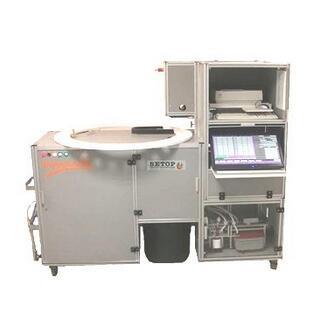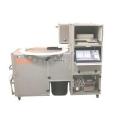方案详情
文
水果生产应适应未来经常与稀缺资源,特别是淡水和肥料有关的情况。在非生物胁迫条件下,为了优化灌溉和施肥,需要新的以生物为基础的水果生产策略,即考虑ac计数树的生长和水分状况。据推测,在采前时期,适度的非生物胁迫,无论是否存在氮源亏缺,都可以在不牺牲产量和果实质量的前提下,减少因病害和因营养生长减少而修剪重量造成的采后损失
方案详情

Acta Sci. Pol. Hortorum Cultus, 18(1) 2019,207-217ISSN 1644-0692 e-ISSN 2545-1405 DOI: 10.24326/asphc.2019.1.21www.acta.media.pl Atay, E., Hucbourg, B., Drevet, A., Lauri, P.E. (2019). Effects of preharvest deficit irrigation treatments in combination withreduced nitrogen fertilization on orchard performance of nectarine with emphasis on postharvest diseases and pruningweights. Acta Sci. Pol. Hortorum Cultus, 18(1), 207-217. DOI: 10.24326/asphc.2019.1.21 ORIGINAL PAPER Accepted: 09.09.2018 EFFECTS OF PREHARVEST DEFICIT IRRIGATION TREATMENTSIN COMBINATION WITH REDUCED NITROGEN FERTILIZATIONON ORCHARD PERFORMANCE OF NECTARINE WITH EMPHASISON POSTHARVEST DISEASES AND PRUNING WEIGHTS Ersin Atay13区,Bruno Hucbourg', Aurore Drevet, Pierre-Eric Lauri Mehmet Akif Ersoy University, Food Agriculture and Livestock School, Department of Crop and Livestock Production, HorticultureProgramme, Burdur, Turkey ‘GRCETA de Basse Durance, Extension service, Route de Molleges, 13210, St Remy de Provence, France SYSTEM,Univ Montpellier, INRA, Cirad, Montpellier SupAgro, CIHEAM-IAMM,Montpellier, France ABSTRACT Fruit production should be adapted to future scenarios that are frequently associated with scarce resources,especially freshwater and fertilizers. New biologically-based fruit production strategies, i.e. taking into ac-count tree growth and water status, are required to optimize irrigation and fertilization under abiotic stressconditions. It was hypothesized that a moderate abiotic stress, here deficit irrigation with or without nitro-gen deficit, in the preharvest period, could decrease postharvest losses due to diseases and pruning weightsdue to reduced vegetative growth, without sacrificing the yield and fruit quality. This study was conductedover two years using the same trees of Moncante'nectarine cultivar grown in a commercial orchard. Treeswere assigned to three treatments: (1) full irrigation at 80% estimated crop evapotranspiration (ETc), (2)deficit irrigation, i.e. at 75% of full irrigation, and (3) deficit irrigation and deficit nitrogen, i.e. at 75% offull irrigation and 75% of usual N-fertilization adopted by the grower in this commercial orchard. Deficit ir-rigation alone and in combination with deficit nitrogen reduced postharvest diseases and pruning weightswithout significant yield losses. Our results suggest that ET -based approaches of reduced water irrigationmay be a sustainable way to decrease phytosanitary inputs and workload in the orchard while maintainingthe orchard performance. Key words: climate change, drought, fruit shelf-life, Monilinia sp., picking time, tree water status Peaches and nectarines are one of the most com-mercialized fruit crops in the world [Vendramin et al.2014] with approximately 25 million tons producedworldwide in 2017 [FAO 2018]. Due to the increas-ing human population and climate change, the de-mand for useful water and food will shortly be se-verely increased [Jenkins 2003]. In that context, defi- cit irrigation is an option to reduce water use withlow effect on yield and fruit quality [Naor 2006, Atayet al. 2017]. Deficit irrigation strategies can dramati-cally influence the orchard performance of nectarine[Atay et al. 2016]. Indeed, peach and nectarine fruitcontain almost 87% water [Crisosto and Valero2008]. This ratio is about 50-70% for leaf and wood tissues in fruit trees [Rom 1994]. Likewise, nitrogenis an essential element for plants, and nitrogen-basedfertilization itself entails dramatic effects on orchardperformance, because important compounds such asamino acids, proteins, enzymes, nucleic acids, andchlorophyll, contain nitrogen [Johnson 2008]. Undersevere abiotic stress (e.g. severe water and nitrogendeficits), photosynthesis is reduced, which can penal-ize the orchard performance, especially yield andfruit quality [Atay et al.2016,2017].Nectarine treesneed severe pruning, and orchard practices that de-crease pruning weight can reduce pruning costs. Al-so, the loss caused by postharvest diseases is themajor factor in food1andnutritionaliiinsecuritv[Mditshwa et al. 2017, Zhang et al. 2017]. Posthar-vest diseases can be eliminated by synthetic fungi-cides [Sharma et al. 2009]. However, synthetic fungi-cides pose a health risk to humans, animals, and theenvironment, as well as the fungicide resistance bythe pathogen [Zhang et al. 2017]. There are strictworldwide regulations on fungicides use, and theiruse in the postharvest period is completely banned insome European countries [Wisniewski et al. 2016].Few works have focused on the impact of orchardpractices on the postharvest diseases of horticulturalcrops [Mditshwa et al. 2017]. All in all, finding safe,eco-friendly and effective alternative methods tosynthetic fungicides for postharvest disease control ofhorticultural crops, is very meaningful [Sharma et al.2009, Wisniewski et al. 2016, Zhang et al. 2017].In the present study, we hypothesized that deficitirrigation, possibly combined with deficit nitrogen, inthe preharvest period, would have dual effects, firstlyreducing vegetative growth and therefore decreasingthe need for summer and winter pruning, and second-ly increasing the peach firmness thus decreasing thepostharvest disease incidence. Based on previousunpublished experiments, our objective was to de-termine practical routes for a good compromise be-tween deficit irrigation and the maintenance of yieldand fruit quality. MATERIALS AND METHODS Experimental site and plant material. This studywas conducted in a commercial orchard of yellow-fleshed ‘Moncante’nectarine on the seedling root- stock Prunus persica cv. ‘Montclar’,established inJanuary 2009at6 m×3 m spacing in Caissargues,located in the south-east Mediterranean region ofFrance. Trees were trained since orchard establish-ment as goblets. The soil was clay loam with 50% tc60% of stones. Hand thinning after the physiologicalfruit drop was carried out to homogenize fruit load(1.6 to 2.0 fruit per shoot; 160 to 175 shoots per tree).Standard crop husbandry practices were applied tothe orchard throughout the study. Irrigation and nitrogen treatments. Irrigationand nitrogen (N) treatments were applied over twoconsecutive years (2013 and 2014) in three adjacentrows using the same trees for the same treatments inboth years. Before this study, all trees in the orchardreceived full irrigation and standard rates of fertiliz-ers. After verification of the homogeneity of the treesgrowth, water regimes were replicated five timesrandomly distributed along the rows including fiveuniform trees in each replication, yielding to 25 treesper treatment. Data were collected from the centralthree trees in each replication. The orchard was irri-gated on a daily basis (4 pulses a day using an auto-matic timer) with a subsurface drip irrigation system. The irrigation system was placed at 0.25 m depth inthe soil and 0.60 m apart from each tree towards theinter-row. Emitters had a debit of 1.6 1 h-at 0.75 mspacing along the row. Trees were assigned to threetreatments: control, i.e. full irrigation, FI, corre-sponding to grower irrigation at 80% of estimatedcrop evapotranspiration (ETe); deficit irrigation,DI,was set at 75% of FI till the last fruit picking; andDI till the last picking with a deficit irrigation, DI,as previously, and a deficit N (DN) fertilization at75% of the usual N fertilization (120 kg haperyear, based on soil analyses) practice in this orchard(DI + DN). After harvest, N was applied at 20 kgha per year in all treatments. Irrigation waterquantity for FI treatment was calculated accordingto ETe values (plant coefficient,K。=0.8) using theFAO standardized Penman-Monteith equation, (ET,× Ke)-rainfall, where ETrepresents the referenceevapotranspiration [Allen et al. 1998]. Climate datawere obtained fromlcanearby weather station(Fig.1). Irrigation began in the first week of Marchand ended just before the autumn rains (beginningof September). Atay, E., Hucbourg, B., Drevet, A., Lauri, P.E. (2019). Effects of preharvest deficit irrigation treatments in combination withreduced nitrogen fertilization on orchard performance of nectarine with emphasis on postharvest diseases and pruningweights. Acta Sci. Pol. Hortorum Cultus, 18(1), 207-217. DOI: 10.24326/asphc.2019.1.21 m2013 Rainfall 2014Rainfall --2013Max. Temp. --2014 Max. Temp.--2013 Min. Temp. --2014 Min. Temp. Fig. 1.Daily rainfall and temperature data recorded in the preharvest and harvest period at the experimentation ar-ea in 2013 and 2014. Arrows indicate rainfall at each picking time Data collection Tree water status. To check tree water status in thethree treatments, midday stem water potential (SWP)was measured nine times along the growing seasonbeginning when maximal temperatures raised above25°C. Measurements were made at solar noon witha pressure chamber (Arimad-3000; Plant Water Poten-tial Measurement Device for Agricultural, Israel) usingthe leaves located in the inner part of tree canopy. Se-lected leaves were inserted into a plastic bag coveredwith aluminum foil at least one hour before measure-ment to ensure water equilibrium between leaves andstem [Naor et al. 2008]. At each measurement date,SWP was determined using seven leaves per treatment.Fruit growth dynamics. In both study years,125 fruit per treatment were tagged, and fruit cheekdiameter at the closest mm was determined. Meas-urements started when the fruit reached approximate-ly 40 mm in diameter and continued up to the firstpicking time. Yield. Fruit that were tree-ripened were picked onJuly 24, July 29, and August 2 in 2013 and on July 4,July 7, and July 11 in 2014. Fruit picking was done atthe beginning of sunrise and completed before mid-day. At each picking,fruittwere immediatelyweighted, and yield was calculated in terms oft ha-1and yield efficiency (kg cm" trunk cross-sectionalarea (TCSA)) was described as the ratio of the weightof fruit per unit area of TCSA. Trunk girth (assumingcircular cross-section) was measured at 20 cm abovethe budding point to0ddetermine TCSAA((cm).The fruit were graded in terms of cheek diameter.On a sample of 30 fruit (20 fruit in 2014) per treat-ment taken from the most represented fruit size classat each picking time, fruit weight (g), fruit firmness(kgcm), soluble solids content SSC (%), titratableacidity (g L) and juiciness (ratio of the juice to drymatter) were measured with the computer-controlledquality control device -“Pimprenelle”[Setop GiraudTechnologie, www.setop.fr]. Postharvest diseases. To reveal the effects of ir-rigation and N treatments on the postharvest diseasescaused by fungal pathogens (Monilinia sp., Rhizopussp. and Botrytis sp.), fruit were transported to thelaboratory immediately after each picking, and placedin a cold storage at 0.5℃ for pre-cooling during thefirst 24 hours. Then fruit were kept in another roomat 22℃ and 90% relative humidity for ten days. Ob-servations of postharvest diseases were conducted 5,7 and 10 days after picking (DAP) that are a criticaltime for retailers, supermarkets, and consumers, re-spectively. For the evaluation of postharvest diseases,a sample of 150 fruit without injuries taken from themost represented fruit size class was selected at eachpicking time. The most represented fruit size classwas 73-79 mm for the first and second picking, and67-73 mm for the third picking for all treatments inboth study years. Harvest boxes were never usedbefore for minimizing the sanitation issues. Aftereach observation at 5 DAP and 7 DAP, damaged fruitby postharvest diseases were removed from the boxesto prevent further pathogen dissemination. Pruning weights. Summer (mid-August, 2013only) and winter (dormant, 2013 and 2014) pruningweights were recorded immediately following manu-al pruning. Data analysis All data were analyzed using SAS-JMP softwareversion7.0 (http://www.jmp.com/software/)..Therandom-effect was included in the fit model, andmean values were separated using Least SignificantDifference (LSD) multiple comparison tests. In allanalyses, threshold for statistical significance was setat P<0.05. RESULTS Tree water status. SWP was significantly lower inFI than in the other treatments commencing threeweeks before the first picking in the preharvest period.After harvest, there were no significant differencesTXTamong the treatments for SWP. SWP did not differbetween DI and DI+DN over the season (Tab. 1). Period Date FI DI DI+DN P June 18 -0.71 ±0.17 -0.98 ±0.22 -0.91±0.11 0.0643 Postharvest June 20 -0.46 ±0.06 -0.52 ±0.10 -0.50±0.09 0.5854 June 25 -0.65 ±0.05 -0.70 ±0.18 -1.07±0.25 0.0664 July 2 -0.56 ±0.0b -1.34 ±0.3a -1.33±0.23a 0.0001 July 10 -0.90 ±0.1b -1.64 ±0.10 a -1.59±0.30a 0.0001 July 17 -1.26 ±0.0b -1.66 ±0.2a -1.81±0.17a 0.0016 August 13 -0.96 ±0.09 -0.87 ±0.06 -0.91±0.11 0.3590 September3 -1.12 ±0.12 -1.05 ±0.04 -1.09±0.08 0.6821 October 3 -1.13 ±0.10 -1.10 ±0.09 -1.03±0.08 0.0796 Values are means +standard deviation (SD). Within each measurement date, different letters indicate significant differences at P<0.05FI: full irrigation; DI: deficit irrigation; DI+DN: deficit irrigation with deficit N Fig. 2. Time-dependent changes of fruit cheek diameter of ‘Moncante’nectarine in response to irrigation and N treat-ments. (A) 2013 and (B) 2014. The values are means ±SD. FI: full irrigation; DI: deficit irrigation; DI+ DN: deficitirrigation with deficit N Fig. 3. Effect of irrigation and N treatments on the yield of ‘Moncante’nectarine at each picking time. (A) 2013 and(B) 2014. The values are means ±SD. Within each picking time, different letters indicate significant differences atP<0.05. FI: full irrigation; DI: deficit irrigation; DI + DN: deficit irrigation with deficit N MFI ODI ODI+DN Fig. 4. Effect of irrigation and N treatments on yield effi-ciency of ‘Moncante’nectarine. The values are means±SD. FI: full irrigation; DI: deficit irrigation; DI + DN:deficit irrigation with deficit N Atay, E., Hucbourg, B., Drevet, A., Lauri, P.E. (2019). Effects of preharvest deficit irrigation treatments in combination withreduced nitrogen fertilization on orchard performance of nectarine with emphasis on postharvest diseases and pruningweights. Acta Sci. Pol. Hortorum Cultus, 18(1), 207-217. DOI: 10.24326/asphc.2019.1.21 ■FI ODI ODI+DN B Fig. 5. Effect of irrigation and N treatments on fruit size class distribution of ‘Moncante’nectarine. (A) 2013 and (B)2014. The values are means ±SD of all three picking times. Within each size class, different letters indicate significantdifferences at P<0.05. FI: full irrigation; DI: deficit irrigation; DI +DN: deficit irrigation with deficit N Table 2. Fruit weight, soluble solids content (SSC), firmness, acidity and juiciness of ‘Moncante’nectarine in response toirrigation and N treatments Year Treatment Weight SSC Firmness Acidity Juiciness (g) (%) (kg cm) (gL ) 2013 FI 203±17 11.70±1.18b 5.59±1.09b 8.05±0.70 7.43±0.72a DI 196±20 13.75±1.23a 6.04±0.97a 7.57±1.45 6.40±0.69b DI+DN 201±18 13.70±1.62a 5.75±1.02ab 7.43±0.61 6.70±0.55b P 0.1015 0.0001 0.0301 0.4567 0.0166 2014 FI 190±25 a 10.86±1.48b 6.12±0.97b 8.07±0.70 3.57±0.72 DI 174±24b 13.00±1.48a 6.94±0.99a 8.80±1.45 2.40±0.69 DI+DN 176±24 b 10.33±1.07b 5.88±0.97b 7.83±0.61 3.83±0.55 P 0.0003 0.0001 0.0002 0.1311 0.0894 The values are means +SD of the three picking times. Within columns, different letters indicate significant differences at P<0.05. FI: full irriga-tion; DI: deficit irrigation; DI +DN: deficit irrigation with deficit N Fruitgrowthdynamics and yield. In 2013(Fig. 2A) and 2014 (Fig. 2B), fruit cheek diameterwas not different between treatments over the wholeseason. Cumulative yield in both 2013 (Fig. 3A) and2014 (Fig.3B) was unaffected by treatments. In gen-eral, the effects of treatments on yield differed de-pending on the picking time without clear propensitywithin the two years. As a whole, there were no sig-nificant differences in cumulative yield among thetreatments. Yield efficiency was not affected bytreatments in both study years (Fig. 4). FI resulted in a higher yield in the ‘>79 mm’sizeclass compared to the other treatments in both years.Proportion of fruit in the 73-79 mm and 67-73 mmsize class that covers the greatest part of the totalyield was 48% and 33% (Fig. 5A) and 37% and 38%(Fig. 5B) in 2013 and 2014, respectively. In 2013, FI resulted in lower SSC in comparisonto other treatments. Acidity was unaffected by treat-ments. Juiciness was higher in FI than in the othertreatments (Tab. 2). In 2014, FI resulted in higherfruit weight in comparison to the other two treat- ments. SSC was higher in DI that also had a higherfirmness than the other treatments. Acidity and juici-ness were unaffected by treatments (Tab. 2). Postharvest diseases. In 2013, the effect oftreatments on postharvest diseases interacted with thepicking time at 5 DAP. Effects of FI and DI +DN onpostharvest diseases were similar in all picking times.The third picking had the highest postharvest diseasesat 7and 10 DAP (Tab.3). In 2014, an interaction between treatment andpicking time was found at 7 DAP. Effects ofDI andDI+DN on postharvest diseases were similar at both7 DAP and 10 DAP (Tab. 4). Pruning weights. Winter pruning weight in both2013 (Fig. 6A) and 2014 (Fig. 6B) was higher in FIthan in the other treatments. FI had the greatest, andDI +DN had the least, cumulative pruning weight in2014 (Fig. 6B). Table 3. Losses caused by postharvest diseases in response to irrigation and N treatments at days 5, 7 and 10, after eachpicking in 2013 Test Treatment Picking time Losses (%) 5 DAP 7 DAP 10 DAP FI first 16.57±9.12 22.86±12.29 46.86±15.47 second 3.43±2.39 8.00±7.67 28.00±12.02 DI third 4.00±4.33 9.14±5.50 25.71±8.08 first 7.73±7.45 68.57±15.91 82.86±11.25 second 6.29±8.43 37.14±9.48 62.86±12.12 third 4.00±3.26 56.00±25.44 72.57±24.63 DI+DN first 22.99±10.58 81.71±7.17 89.71±4.33 second 9.71±6.58 74.86±16.59 84.57±9.39 third 28.57±3.50 89.14±7.40 93.71±5.11 FI 15.43±10.57 57.71±28.49 a 73.14±22.10 Mean DI 6.48±6.43 40.00 ±30.39 b 58.48±26.27 DI+DN 12.19±12.48 51.43 ±36.92 a 64.00±32.63 Effect P 0.0153 0.0326 0.0913 first picking 8.00±8.38 13.33±10.83c 33.52±14.98c Mean second picking 5.90±6.43 53.90±21.49 b 72.76±17.97 b third picking 20.19±10.66 81.90±12.06 a 89.33 ±7.28 a Effect P 0.0007 0.0001 0.0001 Treatment × picking time P 0.0034 0.1501 0.2326 interaction The values are means ± SD. Data are transformed (trigonometric-arcsin) to stabilize variance. Within columns means with different letters amongtreatments and picking times are significantly different at P<0.05. DAP: days after picking.FI: full irrigation; DI: deficit irrigation; DI+DN:deficit irrigation with deficit N Table 4. Losses caused by postharvest diseases in response to irrigation and N treatments at days, 5, 7 and 10, after eachpicking in 2014 Test Treatment Picking time Losses (%) 5 DAP 7 DAP 10 DAP FI first 0.19±0.74 4.95±4.64 14.48 ±10.88 second 1.71±2.11 20.38±11.32 25.90±14.06 DI third 一 2.67±3.49 12.38±9.39 first 0.00±0.00 2.48±2.83 7.81±7.44 second 1.33±2.38 10.48±9.39 14.86±11.13 third 0.00±0.00 9.52±8.55 DI+DN first 0.00±0.00 0.95±2.57 8.00±6.85 second 0.38±1.02 8.19±3.87 15.81±5.39 third 0.00±0.00 9.33±6.15 FI 0.95±1.73 9.33±10.71 17.59±12.83 a Mean DI 0.67±1.79 4.32±7.15 10.73±9.46b DI+DN 0.19±0.72 3.05±4.53 11.05±6.93 b Effect P 0.1786 0.0015 0.0001 first picking 0.14±0.82 b 2.81±3.99 9.62±8.71b Mean second picking 1.05±2.04a 13.10±10.12 18.91±12.11a third picking - 0.71±2.08 10.71±9.26b Effect 0.0040 0.0001 0.0037 Treatment x picking time P 0.1678 0.0066 0.4650 interaction The values are means ±SD. Data are transformed (trigonometric-arcsin) to stabilize variance. Within columns means with different letters amongtreatments and picking times are significantly different at P <0.05.-: data not collected. DAP: days after picking. FI: full irrigation; DI: deficitirrigation; DI + DN: deficit irrigation with deficit N Fig. 6. Effect of irrigation and N treatments on fresh pruning weights of ‘Moncante’nectarine. (A) 2013 and (B)2014. The values are means +SD. Within each pruning time, different letters indicate significant differences atP<0.05. FI: full irrigation; DI: deficit irrigation; DI + DN: deficit irrigation with deficit N DISCUSSION Fruit growth dynamics and yield. No distinct‘plateau phase’ was seen during the fruit growth of‘Moncante’, a mid-season nectarine cultivar. Theplateau phase is in fact very short in early-ripeningpeach and nectarine cultivars [Bassi and Monet2008]. In general, fruit size values, measured eitherfrom cheek diameter or fruit weight, was higher, butSSC was lower, in fruit from FI-treated trees. Ourresults thus confirmed the literature references statingthat fruit size is tightly associated with irrigationwater quantity used, and that deficit irrigation reduc-es the fruit size [Naor 2006], but increases SSC[Crisosto et al. 1997, Atay et al.2017]. Cumulative yield and yield efficiency of FI-tre-ated trees were rather similar to the other two treat-ments in both study years. Strong deficit irrigationreduces the yield [Naor 2006]. To minimize twinfruit, yield and fruit quality problems, the thresholdlevel of SWP has been suggested as -2.0 MPa in thecase of postharvest irrigation of nectarines in Israelconditions [Naor 2006]. This threshold is close to themaximal negative values obtained in our experimentfor DI and DI+ DN, around -1.81 MPa ±0.17, incomparison to FI-treated trees (max.-1.26 ±0.08).A deficit irrigation as done here could then be con-sidered as moderate. Because this threshold level isinfluenced by orchard to orchard, regional experi-ments are recommended [Johnson 2008]. Postharvest diseases.Our results showed that, atleast in 2014, deficit irrigation associated or not withnitrogen deficit could decrease the postharvest dis-eases, however, with possible interactions with pick-ing time, the third picking having a higher frequencyof postharvest diseases, especially after a longer stor-age time. In the present study, we can deduce that DIalone and in combination with DN reduced the post-harvest diseases. Perez-Pastor et al. [2007] found thatfungal attacks mainly caused by Rhizopus sp. andMonilinia sp. decreased during the storage of apricotunder deficit irrigation. Cuticle and epidermis anato-my of fruit can vary with orchard practices [Konarska2014], and DI and DN may increase continuous andthicker cuticle that protects the fruit against patho-gens [Daane et al. 1995, Crisosto et al. 1997]. Be-cause direct penetration of fungal pathogens to fruitthrough an intact cuticle has never been seen, cuticu- lar microcracks, occurring as the fruit grows natural-ly, and deeper spontaneous cracks in the wall of epi-dermis, create a convenient site for pathogen attacksin nectarine [Nguyen-the 1991, Konarska 2014].In the present study, probably both types of crackswere more abundant in fruit from FI-treated trees, incomparison to the others. Three hypotheses may beproposed. This could be first due to an increasedfrequency of cracks positively related to a higher fruitvolume surface in slightly larger fruit in FI. Second-ly, while the number of stomata on the fruit is estab-lished at anthesis, stomatal behavior differs duringthe fruit growth [Ishida et al.1990]. Stomatal open-ing in the epidermis, which makes the fruit moresusceptible to pathogens, decreases with increasingabscisic acid (ABA), the synthesis of which increasesunder abiotic stress (e.g. DI) [Terry et al. 2007].There is a good positive correlation between middaySWP and midday stomatal closure [Marsal and Gi-rona 1997]. Thus, in the present study, SWP in thepreharvest period was higher/more negative in DI andDI+DN-treated trees in comparisonn to FI-treatedtrees (see Tab. 1). Thirdly, secondary metabolites(e.g. amino acids, alkaloids, phenolics, phytoalexins),that are key components of defense mechanisms,increase in response to abiotic stress factors [Sahebiet al. 2017]. The incidence of postharvest diseases was higherat the third picking in 2013, while it was higher at thesecond picking in 2014. Overall, postharvest diseasesremained relatively lower in 2014 than in 2013.Losses caused by postharvest diseases could be af-fected by relative air humidity occurring a few daysbefore and during the picking time. Thus, the relativehumidity in the ambient air is determined by tem-perature and water vapor in the surrounding area, andtotal rainfall during the fifteen-day period during thepreharvest and harvest period at the research area wastwo-fold higher in 2014 (72 mm) than in 2013(36 mm) (see Fig..J1). However, mean maximumtemperature values in the same fifteen-day periodwere lower in 2014 (27℃) than in 2013 (32°℃). Thetrend of minimum temperature in the same fifteen-day period was similar to that of maximum tempera-ture, being close to 16℃ and 19℃ in 2014 and 2013,respectively. Microcracks on fruit surface increasewith increasing rainfall [Konarska 2014]. Thus rain-fall triggers relative air humidity, especially in hot days. Also, stomatal opening increases with increas-ing relative humidity in the ambient air [Urban et al.2017]. As mentioned above, both microcracks andstomatal opening constitute open ways to pathogenspores that decay fruit in a short time frame. Pruning weights. In the present study, DI com-bined with DN was the most effective treatment inreducing the cumulative pruning weight. DI decreas-es the pruning weight [Miras-Avalos et al. 2017].Peach and nectarine trees respond very dramaticallyto N applications that promote vegetative growth[Crisosto et al.1997]. Our results suggest that reduc-ing N fertilization, here by 25% compared to theconventional inputs in this orchard, may be an effi-cient way to reduce pruning weights. CONCLUSIONS From the scientific perspective, the most im-portant output of the present study is that deficit irri-gation alone and in combination with a deficit innitrogen could reduce the pruning weights and alsopartly losses caused by postharvest diseases. Froma practical perspective, deficit irrigation and a deficitin nitrogen can be used as levers to partly decreasethe use of chemicals (e.g. fungicides and stearic ac-id), physical treatments (e.g. ultraviolet irradiationand hot water dips) and microbial antagonists (e.g.yeasts and bacteria) that are commonly used to re-duce postharvest diseases in fruit crops. Deficit irri-gation, especially when it is associated with a deficitin nitrogen resulted in less pruning weight than FI,which can reduce labor costs for pruning. Moreover,it is likely that the reduction of shoot growth couldalso reduce aphid infestation indirectly [Grechi et al.2008] and therefore pesticide needs along the season.DI and DI+ DN resulted in a slight decrease in largefruit frequency but with non-consistent effect oncumulative yield. As a whole, we consider that deficitirrigation and deficit in nitrogen should be consideredwith more attention in the future to implement lessworkload and less chemical demanding peach andnectarine orchards. ACKNOWLEDGEMENTS Thiswork hasbeen1 partly fundedi by ttheARIMNET (Coordination of the Agricultural Re-search in the Mediterranean Area) research program APMed (Apple and Peach in Mediterranean orchards-Integrating tree water status and irrigation man-agement for coping with water scarcity and aphidcontrol), and TUBITAK (The Scientific and Techno-logical Research Council of Turkey). The authorswarmly thank Christophe Ripolles (SO(rchard manager,Mas de Nages) for permitting us to experiment in hisorchard. REFERENCES ( Allen, R.G., P ereira, L.S. , Raes, D. , Smith , M.(1998).Crop evapotranspiration. G uidelines for c omputingcrop w ater requirements. I rrigation and drainage paper no. 56.FAO, Rome, Italy. ) ( Atay, E ., H ucbourg, B., Drevet, A., La u ri, P. E . (2016). Growth r e sponses to w a ter stress and v a pour pressure deficit in n ectarine. Acta Hortic., 1 13 9, 353-358. DOI:10.17660/ActaHortic.2016. 1 139.61. ) ( Atay, E ., Hucbourg, B . , D revet, A., Lauri, P.E. ( 2017)Investigating effects o f over-irrigation and deficit irri- g ation o n yield and f ruit quality in Pink LadyM‘Rosy Glow’apple. Acta Sci. Pol. H o rtorum Cultus, 16 , 45- 5 1. DOI:10.24326/asphc.2017.5.2. ) ( Bassi, D., Monet,R. ( 2008). B otany and taxonomy. In: Thepeach: b otany, production a nd uses, Layne, D.R., Bas- si,D.(eds.). CABI P ublishing, Cambridge, 1-3 6. ) ( Crisosto, C.H., Johnson, R .S., D eJong, T . , D ay, K.R.(1997). O rchard factors a f fecting p o stharvest stone fruit quality. HortScience, 32,820-823. ) ( Crisosto, C.H. , Valero, D. (2008). Harvesting and p osthar-vest handling of peaches for the fresh market. In: Thepeach: b otany, p roduction a nd uses, L ayne, D.R., Bas-si, D. (eds. ) . CABI Publishing, Cambridge, 575 - 596. ) ( Daane, K . , Johnson, R., Mi c hailides, T., Crisosto,C., Dlott, J., Ramirez, H ., Y okota, G., Morgan, D. (1995). Excess ni-trogen raises nectarine susceptibility to disease and ins e cts. Calif. Agric. , 49,13-18.DOI:10.3733/ca.v049n04p13. ) ( FAO (2018). F AOSTAT database co l lections. Food a ndAgriculture Organization of t he United N ations, Rome. Available: h ttp://www.fao. org/faostat/en/#data/ [d a te of access: 25.05.20181. ) ( Grechi, I ., Sauge, M .H., S a uphanor, B., Hilgert, N. , Se n -oussi, R., Lescourret, F . (2008). H ow does wi n ter prun-ing affect peach t ree-Myzus persicae in t eractions? En-tomol. Exp. A ppl., 128, 369-379. DOI:10.1111/j.1570- 7458.2008.00720.x. ) ( Ishida, M., Hirata, H. , Kitajima, A., Sobajima, Y. (1990) Development a n d density of stomata on fruit surfacesduring f ruit growth i n n ectarine. Japan. Soc. Hortic. Sci., 5 8, 793-800. DOI:10.2503/jjshs.58.793. ) ( Jenkins, M. ( 2003). P rospects for biodiversity. Science,302, 1 175-1177.D O I:10.1126/science.1088666. ) ( Johnson, R .S. ( 2008). N utrient a nd water r e quirements o f peach trees. In: The p each: b otany, production a n d us- es, Layne, D.R., B assi, D. (eds.) . CABI P ublishing, Cambridge, 303-331. ) ( Konarska, A . ( 2014). M o rphological, h i stological and ultrastructural changes in fruit epidermis of apple Ma-lus domestica cv. Ligol (Rosaceae) at fruit set , maturityand storage. Acta Biol. Cracoviensia Ser. Bot., 5 6, 35-48.DOI:10.2478/abcsb-2014-0019. ) ( Marsal, J., Girona, J. (1997). R elationship between leafwater p otential and gas exchange ac t ivity at differentphenological s tages and fruit l o ads in peach tre e s. J.Amer. Soc. H ortic. Sci., 122,415-421. ) ( Mditshwa, A., Magwaza, L. S ., Tesfay, S . Z., Mbili, N. (2017). Postharvest quality and c omposition of organically and conventionally produced fruits: a review. Sci. Hortic., 2 16, 148- 1 59.DOI:10.1016/i.scienta.2016.12.033. ) ( Miras-Avalos, J.M., P erez-Sarmiento, F ., Alcobendas, R ., Alarcon, J.J., Mounzer, O., Nicolás, E . (2017). Maximum daily trunk shrinkage for estimating water needs a nd s cheduling re g ulated def i cit irrigation in peach trees . Irrig . Sci., 35, 69-82. DOI:10.1007/s00271-016-0523-7. ) ( Naor, A. (2006). I rrigation scheduling and evaluation of tree water status in deciduous orchards. Hortic. Rev. 32,1 1 1-116. ) ( Naor, A ., N aschitz, S ., Peres, M., Gal, Y. ( 2008). Responsesof apple fruit size to tree water status and c r op load. T r eePhysiol.,28, 1255-1261. D OI:10.1093/treephys/28.8.125. ) ( Nguyen-The, C. (1991). Structure of epidermis wall, cuti- cle and cuticular microcracks in nectarine fruit. Agron- omie, 11,909-920. ) ( Perez-Pastor, A., Ruiz-Sanchez, M .C., M a rtinez, J . A., Nortes, P .A., Artes,F . , D omingo, R. (2 0 07). Effect ofdeficit irrigation on apricot fruit quality at harvest andduring storage. J. Sci . Food Agric. , 87 , 2409-2415. DOI:10.1002/jsfa.2905. ) ( Rom, C. ( 1 994). F ruit tree growth and d evelopment. I n: T ree fruit nutrition: a comprehensive manual o f decid- uous tree f ruit nutrient needs, Peterson, A.B., Stevens, ) ( R.G., Bramlage, W.J. ( eds.). Good F ruit Grower, Y a-kima, WA,USA,1- 1 8. ) ( Sahabi, M., Hanafi, M.M., v an Wijnen, A .J., Akmar,A.S.N., A zizi, P., I dris, A.S., T aheri, S., F oroughi, M. (2017). Profiling secondary metabolites o f plant de - fence mechanisms and oil p alm i n re sponse toGanoderma boninense attack. Int. Biodeter. Biodegr., 122, 1 51-164.DOI:10.1016/j.ibiod.2017.04.016. ) ( Sharma, R .R., S ingh, D., Singh, R . ( 2 009). Biological c ontrol of postharvest d i seases of fruits a n d vegetablesby microbial a n tagonists: a review. Bi o l. Co n trol, 50, 205-221. D OI:10.1016/i.biocontrol.2009.05.001. ) ( Setop-Giraud Technologie (2018). ‘P i mprenelle’ins t ru-ment, Cavaillon, France. Available: www.se t op.fr. ) ( T erry, L.A., Chope, G.A., G ine Bordonaba, J. ( 2007). Effect of water d eficit irrigation and i noculation w ithBotrytis cinerea on strawberry (Fragaria x ananassa)fruit quality. J . Agri c . Food Chem., 55, 10812-10819.DOI:10.1021/jf072101n. ) ( Urban, J., Ingwers, M.W., McGuire, M.A., T e skey, R.O.(2017). Increase in leaf temperature opens stomata and decouples n et photosynthesis f r om stomatal co n duct- ance i n P inus taeda a n d Populus deltoides x n igra.J. Exp. Bot., 68,1757-1767. DOI:10.1093/jxb/erx052. ) ( Vendramin, E., P e a, G., Dondini, L. , Pa c heco, I., Dettori,M.T., G azza, L . , Scalabrin,S., S t rozzi, F . , T a rtarini, S .,Bassi, D., Verde, I. , Rossini , L. (2014). A unique m uta-tion in a MYB gene co s egregates wi t h th e ne c tarine phenotype in peach. PLoS One, 9, e90574. DOI:10.1371/journal.pone.0090574. ) ( Wisniewski, M . , Droby, S., Norelli, J. , Liu, J., Schena, L.(2016). Alternative management technologies for post- harvest disease control: the journey from simplicity to complexity. Postharvest B iol. Technol., 1 22, 3-10.DOI:10.1016/j.postharvbio.2016.05.012. ) ( Zhang, X . , M i n, D., Li , F., Ji,N., M e ng, D., Li, L. ( 2017). Synergistic effects of l -arginine and m ethyl s a licylate on a lleviating postharvest disease caused b y Botrysis cinerea i n tomato fruit. J. Agric. F ood Chem., 65,4890-4896. DOI:10.1021/acs.jafc.7b00395. ) ersinatay@mehmetakif.edu.tr, atayersin@yahoo.com@ Copyright by Wydawnictwo Uniwersytetu Przyrodniczego w Lublinie https://czasopisma.up.lublin.pl/index.php/asphc EFFECTS OF PREHARVEST DEFICIT IRRIGATION TREATMENTS IN COMBINATION WITH REDUCED NITROGEN FERTILIZATION ON ORCHARD PERFORMANCE OF NECTARINE WITH EMPHASIS ON POSTHARVEST DISEASES AND PRUNING WEIGHTS采前亏缺灌溉与氮肥减量配施对油桃采后病害及修剪质量的影响Ersin Atay1,3, Bruno Hucbourg2, Aurore Drevet2, Pierre-Éric Lauri31Mehmet Akif Ersoy University, Food Agriculture and Livestock School, Department of Crop and Livestock Production, Horticulture Programme, Burdur, Turkey2GRCETA de Basse Durance, Extension service, Route de Molleges, 13210, St Remy de Provence, France3SYSTEM, Univ Montpellier, INRA, Cirad, Montpellier SupAgro, CIHEAM-IAMM, Montpellier, FranceABSTRACTFruit production should be adapted to future scenarios that are frequently associated with scarce resources, especially freshwater and fertilizers. New biologically-based fruit production strategies, i.e. taking into ac-count tree growth and water status, are required to optimize irrigation and fertilization under abiotic stress conditions. It was hypothesized that a moderate abiotic stress, here deficit irrigation with or without nitro-gen deficit, in the preharvest period, could decrease postharvest losses due to diseases and pruning weights due to reduced vegetative growth, without sacrificing the yield and fruit quality. This study was conducted over two years using the same trees of ‘Moncante’ nectarine cultivar grown in a commercial orchard. Trees were assigned to three treatments: (1) full irrigation at 80% estimated crop evapotranspiration (ETc), (2) deficit irrigation, i.e. at 75% of full irrigation, and (3) deficit irrigation and deficit nitrogen, i.e. at 75% of full irrigation and 75% of usual N-fertilization adopted by the grower in this commercial orchard. Deficit ir-rigation alone and in combination with deficit nitrogen reduced postharvest diseases and pruning weights without significant yield losses. Our results suggest that ETc-based approaches of reduced water irrigation may be a sustainable way to decrease phytosanitary inputs and workload in the orchard while maintaining the orchard performance.水果生产应适应未来经常与稀缺资源,特别是淡水和肥料有关的情况。在非生物胁迫条件下,为了优化灌溉和施肥,需要新的以生物为基础的水果生产策略,即考虑ac计数树的生长和水分状况。据推测,在采前时期,适度的非生物胁迫,无论是否存在氮源亏缺,都可以在不牺牲产量和果实质量的前提下,减少因病害和因营养生长减少而修剪重量造成的采后损失。这项研究是用在一个商业果园中种植的‘Moncante’油桃品种的同一棵树进行的,历时两年。乔木被分为三个处理:(1)以80%的估计作物蒸散量(ETc)进行充分灌溉;(2)以75%的充分灌溉进行亏缺灌溉;(3)以75%的充分灌溉和75%的常规施肥进行亏缺灌溉和亏缺施氮。单施亏缺灌溉和联合施亏缺氮降低了采后病害和修剪重量,但没有显著的产量损失。我们的结果表明,基于ETc的节水灌溉方法可能是一种在保持果园性能的同时减少果园植物检疫投入和工作量的可持续方法。Key words: climate change, drought, fruit shelf-life, Monilinia sp., picking time, tree water status关键词:气候变化、干旱、果实货架期、Monilinia sp.、采摘时间、树木水分状况
确定
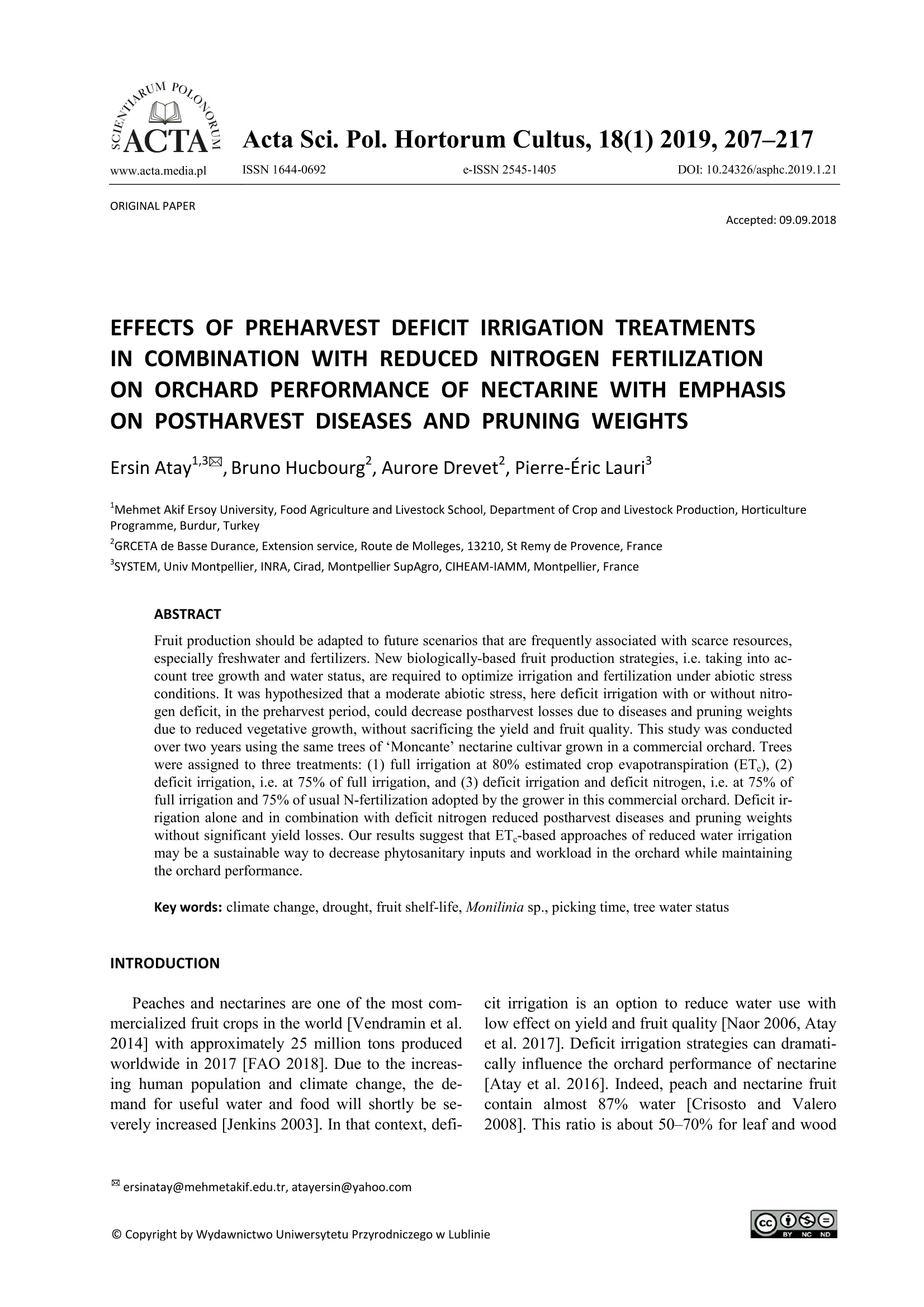
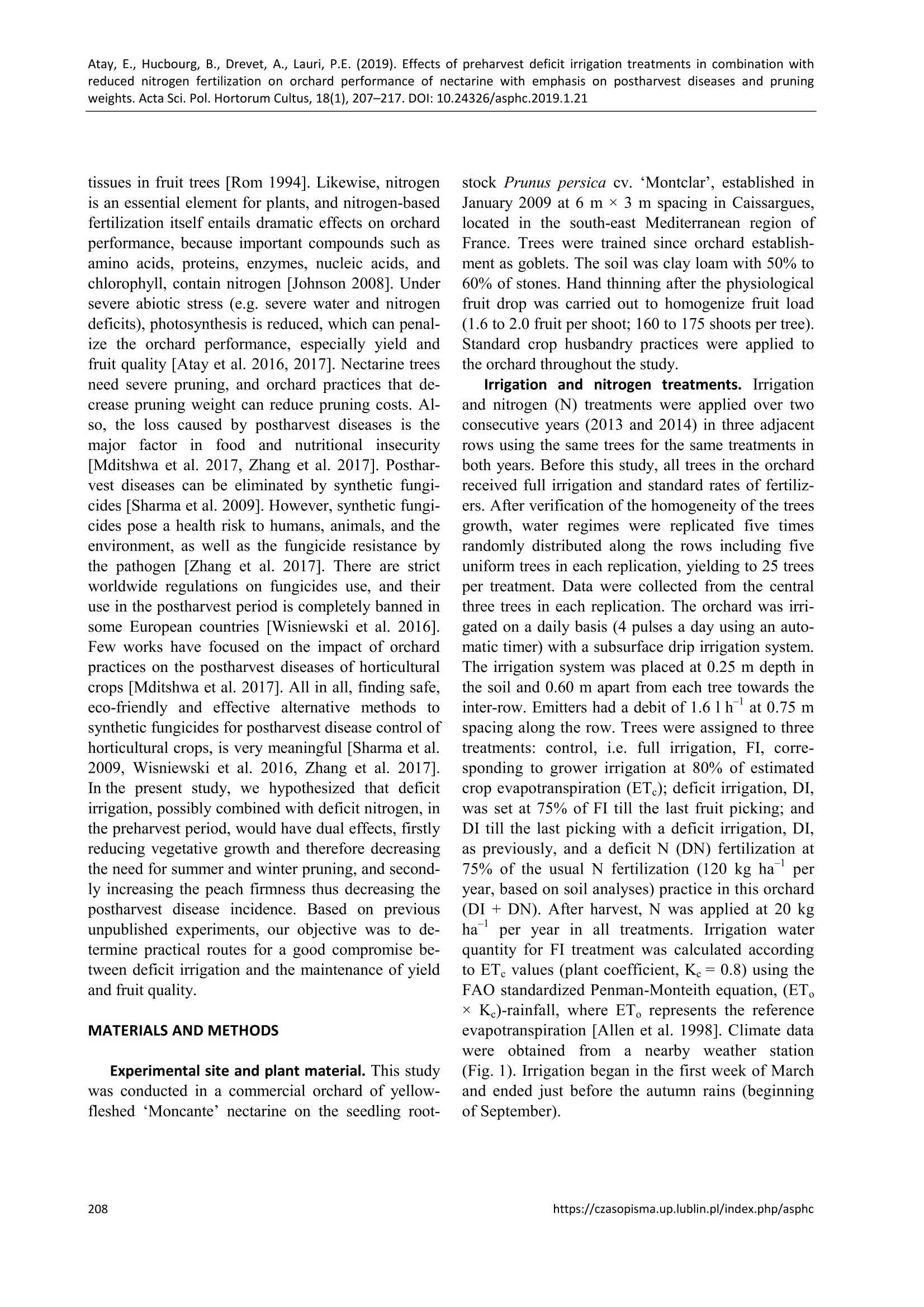
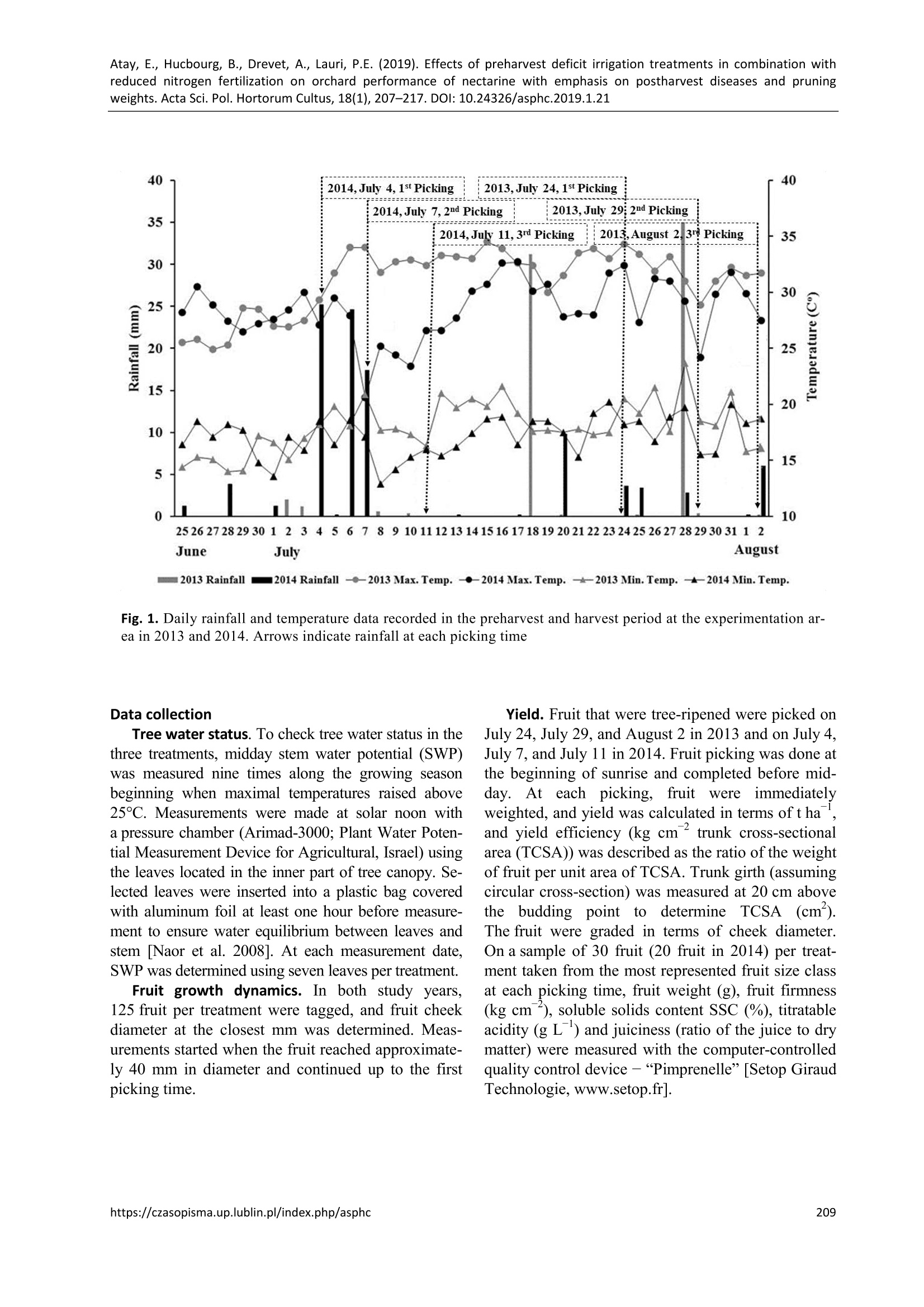
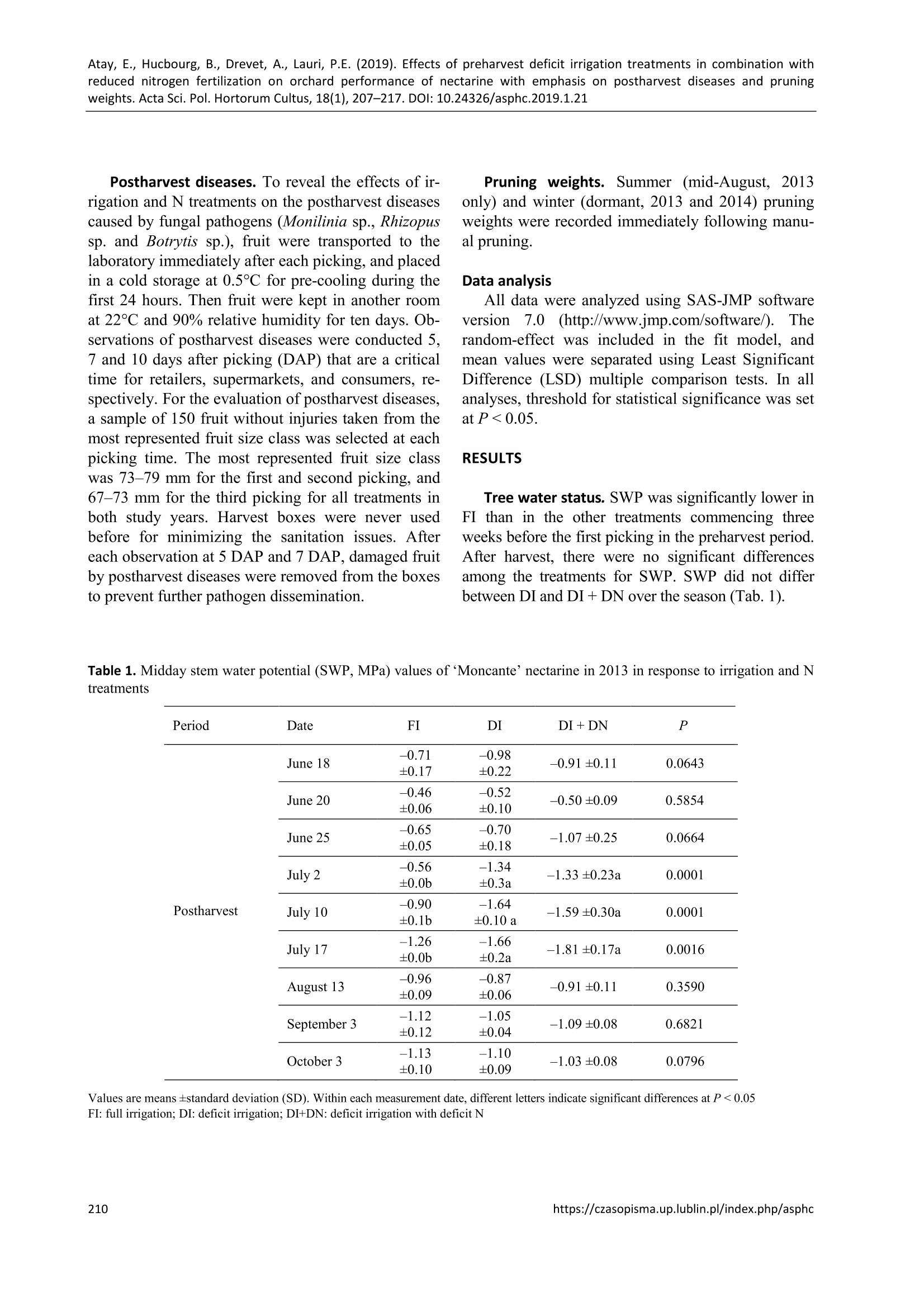



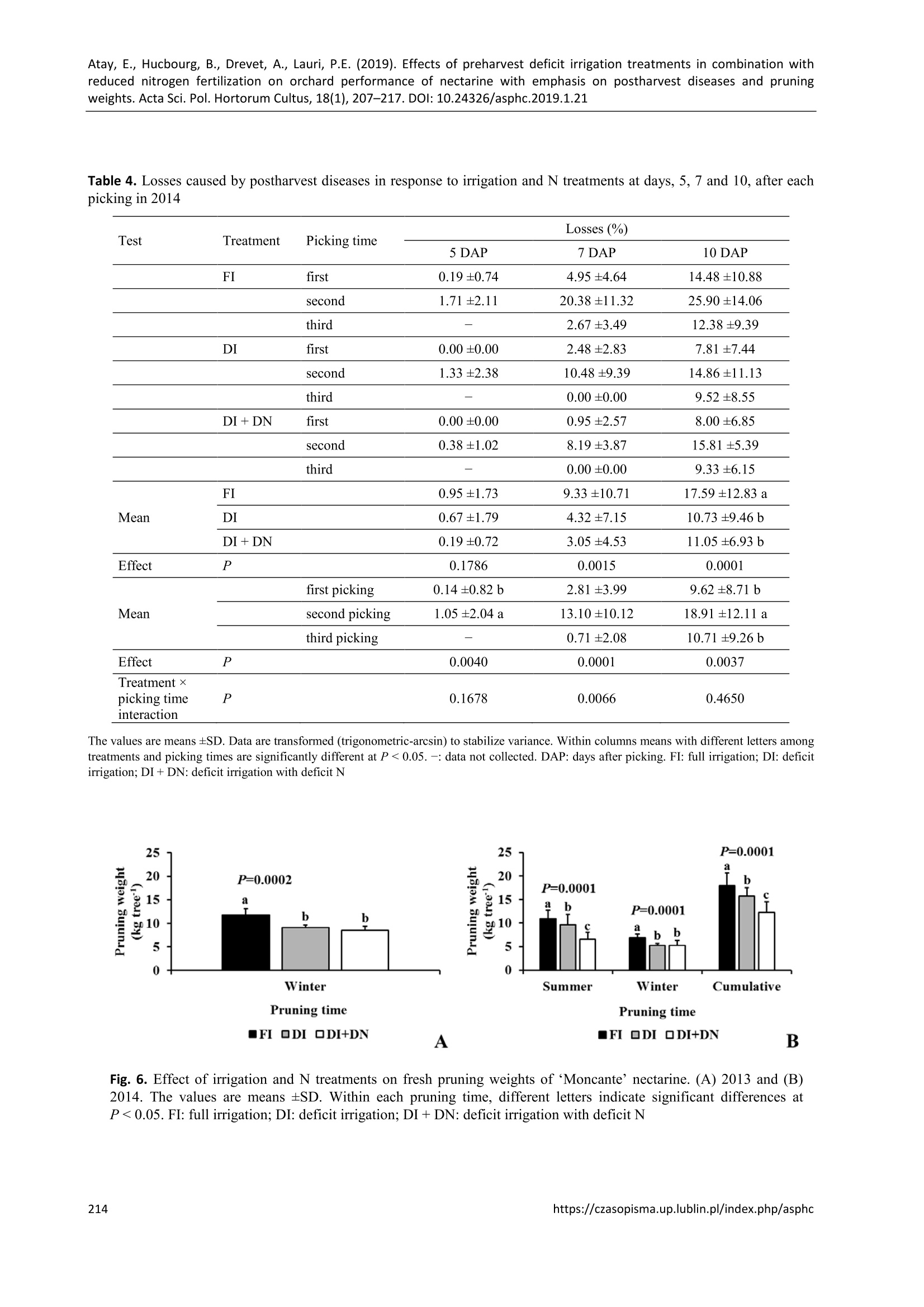

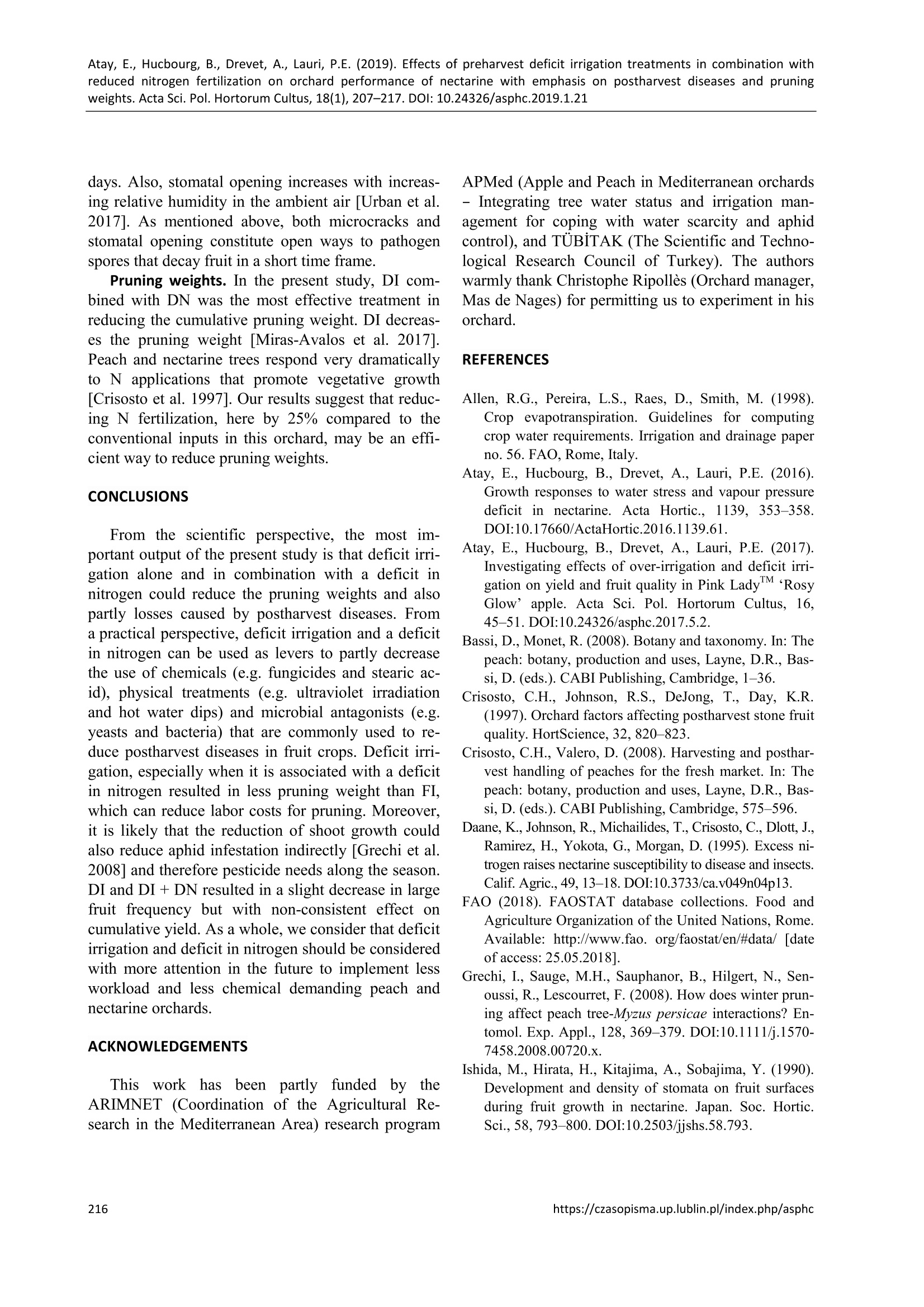
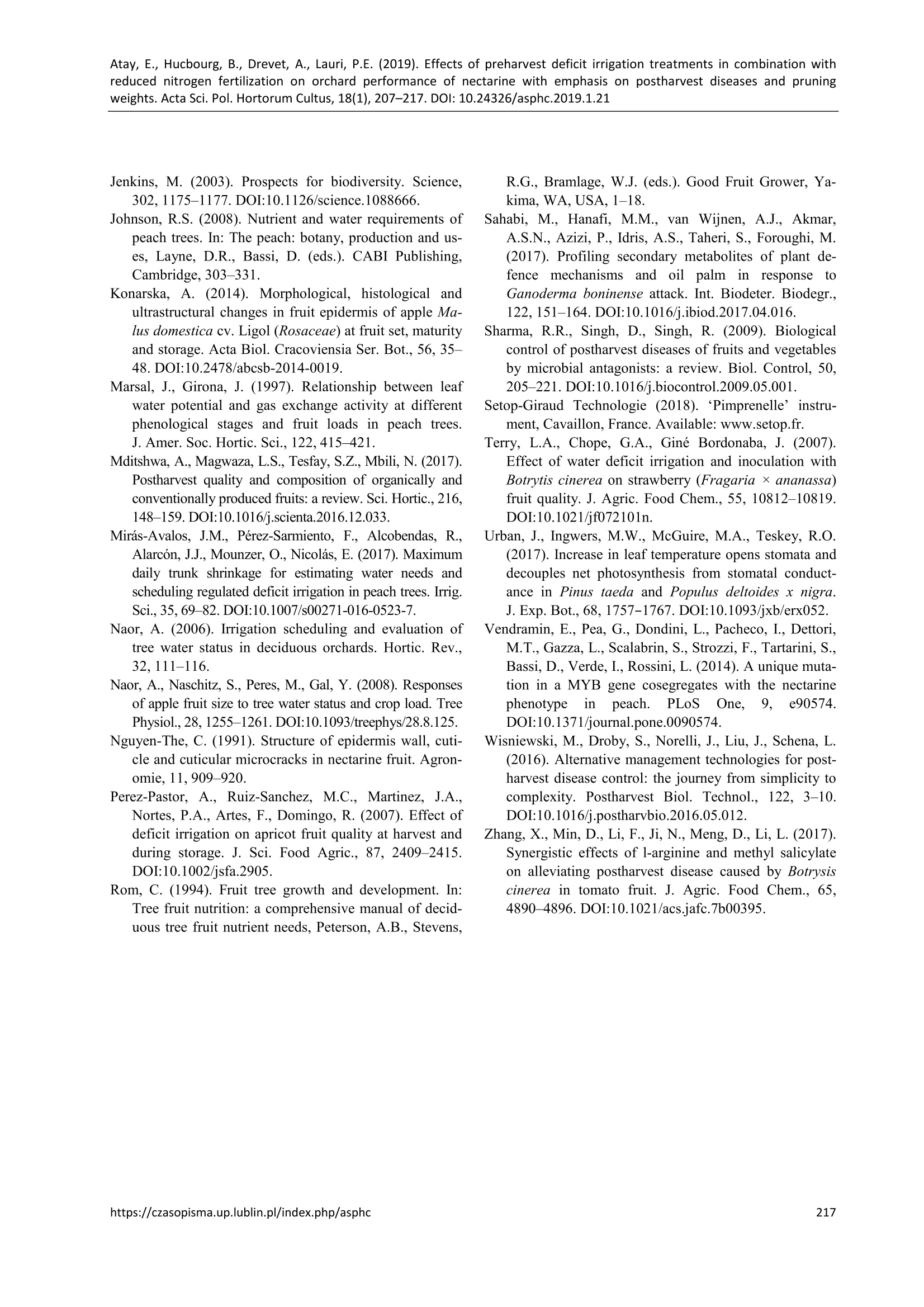
还剩9页未读,是否继续阅读?
图拉扬科技有限公司为您提供《水果油桃中糖度,酸度,干物质检测方案(作物无损检测)》,该方案主要用于蔬菜中营养成分检测,参考标准--,《水果油桃中糖度,酸度,干物质检测方案(作物无损检测)》用到的仪器有Pimprenelle全自动水果质量分选系统
相关方案
更多
该厂商其他方案
更多

